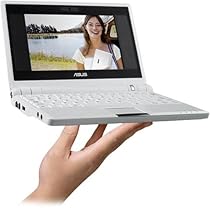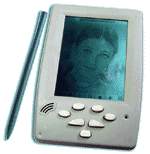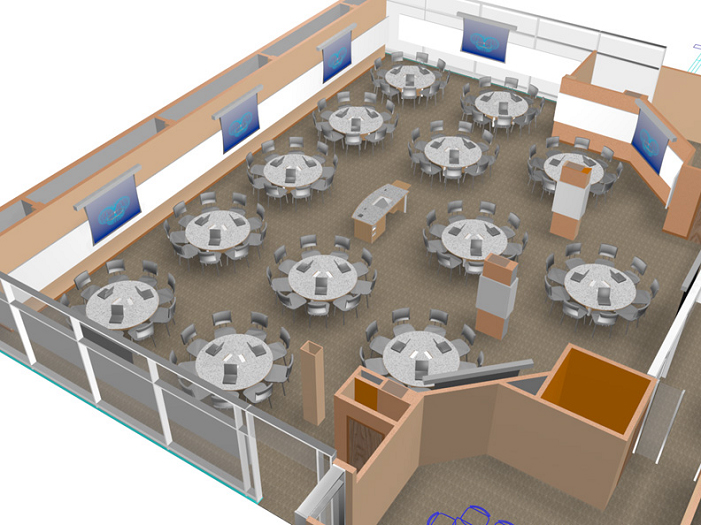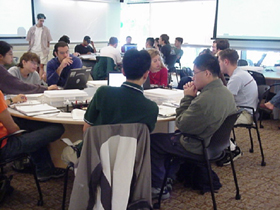
Previously I
proposed a $50 PC as an alternative to the
Children's Machine and the Intel
Classmate PC for Education. Here are a few more technical details on how an educational computer for developing nations might be built. After a discussion with my brother,
Dr John Worthington (who is an Educational Consultant and Psychologist) also some thoughts on educational use.
The name
Web Two Pad Educational Computer (Web2Pad), is intended to indicate the unit will use Web 2 applications and is in a similar physical layout to the Personal Access Display Devices (
PADD) from the Star Trek TV show.
Web2Pad Specification| Type | "candy bar" (landscape) format table "pad" computer |
|---|
| CPU | XScale or similar embedded processor |
|---|
| Size | 148 mm wide x 210 mm high (A5 size) x 40 mm thick |
|---|
| Connectivity | Wireless USB, 2 USB ports |
|---|
| Operating System | Linux based |
|---|
| Camera | None |
|---|
| Media | 512 MB to 64 GB Flash Drive |
|---|
| Input | Rubber Keyboard, Touch Screen, Microphone |
|---|
| Power | NiMH battery pack |
|---|
|
| Display | 142 mm (5.6 Inch) diagonal TFT LCD Optimized for documents: 640 x 480 monochrome (320 x 240 color) |
|---|
The Web2Pad, is proposed as a low cost, open source, tablet computer intended for literacy education of children in developing nations. The design is proposed as an open source project, allowing either non-profit or for-profit manufacture, and distribution of the personal computers. The Web2Pad differs from the Children's Machine (the new name for the MIT "$100 Laptop" of the One Laptop per Child (OLPC) project) and the Intel Classmate PC in using lower cost hardware, less compatibility with existing PC hardware and more emphasis on educational content.
The computers will be low power, with no disk drive and using the
Linux operating system. Low cost wireless networking will allow Internet access from a node, such as at a school.
The computers will be sold directly to the public and also available as a bulk order by organisations. They may be shared by groups, where one per child is not affordable. Pricing is would be US$50 per unit when ordered in volume.
The case would consist of a back plate holding the batteries and motherboard, covered with one piece of molded rubber incorporating the keyboard. The would be no screws, with the motherboard holding all electronics and the screen, clipped into the back plate and the rubber cover fitted over. The front cover of the unit would be replaceable and customized with different keyboard layouts and languages for different countries. Commercial units for office and vehicle use would use different custom keyboard overlays.
The unit would be wedge shaped with the case 40mm at the back, sloping down to 10 mm at the front. This is to allow a comfortable tying angle for the keyboard and screen display. The unit would be approximately half the size and cost of the Children's Machine. This size of unit has been proven by the millions of pocket size "electronic dictionaries" (see below) in use by students.
The LCD screen would be optimized for black and white static document display, with limited color and motion display. The effective screen resolution would be approximately 640 x 480 pixels (VGA) for monochrome documents and 320 x 240 pixels (
QVGA) for color. An LCD back light would be provided for low light conditions. The screen would have a similar per inch pixel resolution to the unit in the Children's Machine but be half the cost, due to the smaller size and more conventional technology (derived from LCD screens used for
car dashboards and
fish finders). The screen would be able to display the equivalent of half a page from a paperback book.
There would be a loudspeaker and microphone but no camera (to save cost). There would be an MP3 player (software), microphone and earphone sockets. Two USB ports and one USB "flash dock" would be provided as well as Wireless
USB.
Flash DockTo reduce cost there would be no SD card socket (as used on the Children's Machine). Instead one of the USB ports would be positioned in a recess in the back of the unit, large enough to accommodate
USB Flash Drives which are
commonly available. This would provide removable memory capacity equivalent to an SD card but without the need for additional hardware or software. Similarly
Wireless USB (WUSB) would be used in preference to WiFi or Bluetooth. Power would be from low cost off the shelf NiMH batteries mounted in a molded holder in the case.
Ajax and Web 2The PC would use an
embedded version of Linux and a low cost processor designed for mobile phones. An example of such technology is the Australian developed
PLEB2 Single Board Computer from
an UNSW/NICTA.
There would be no attempt to provide PC compatibility. The emphasis would be on Ajax based Web 2 applications. The unit would be able to display simple animations, video games and limited slow frame video, but not designed for high quality video display.
While most interest is in the hardware for such projects, it is the educational content and support which is more important. The Web2Pad would be intended primarily for basic literacy. The touch screen could be used with a stylus to teach writing in cursive scripts as well emulating a brush for pictographic languages.
Accessible Educational Content
In addition to a spelling dictionary, the unit would have basic grammar for selected languages. Basic readers would be provided in the local language to encourage the child to read (using the Wikibooks format or other electronic book format). Web based educational packages using Moodle (or similar) would assist teachers and educators to develop further learning materials.
An emphasis would be placed on accessible design of the material, using the W3C Web Accessibility Guidelines. This would allow the use of material on the small screens of the $50 PCs, as well as use of the material by the disabled and for those with limited literacy. The materials would be designed to be upward compatible with ordinary PCs and web browsers. On a larger screen the format of the documents would automatically adjust to fit.
The Web2Pad could be used standalone, with data transferred by USB flash drive. In the classroom the units could communicate via a wireless network and to an Internet gateway. An ad-hoc village mesh network could be used to extend the range of the wireless system without the need for extra hardware. The computers would cooperate to relay data from the school node, with sufficient bandwidth for web browsing and audio. With the built in microphone and speaker (or a low cost headset), the unit could be used as a VoIP phone. An SMS client would also be provided.
A mounting point on the back of the unit would allow it to be securely attached to a wall or desk. With a suction cup, the same mounting point would allow the computer to be attached to the windscreen of a vehicle. Higher priced commercial units may have extra features, such as an A6 clam shell design and more memory, but could use the same educational content.
The computers would be available as a commercial product for anyone to purchase. Use of the units for commercial, business and government activities would not be restricted. It would be expected, for example, that the children would show their parents how to use the computers for the family business. In areas where one laptop per child was not affordable, a unit could be shared by several children or a whole village. The unit might be rented out, much as mobile phones are in some areas.
Cooperation not Individualism the Key
The Children's' Machine and Classroom PC projects assume that widespread provision of computers to children in developing nations will help with their education. The Children's Machine in particular, emphasizes the idea of each child having a unit for themselves for personal use at home and school, rather than share units. However, one laptop per child may not be affordable, nor educationally desirable. An emphasis on cooperation, rather than individualism, both for the students and teachers would be useful.
These educational computers are essentially low cost laptop computers, made cheaper and more rugged by leaving out non-essential components. The question this is what and how much can be left out. The Web2Pad leaves out more hardware and adds more educational content.
But what is needed in an educational computer and how large does it need to be? Should an educational computer be like a regular computer at all? Already I have discussed if the educational computer should be more like a PDA or a smart phone. Apart from mobile phones, are there any examples of widespread popular electronic gadgets used by children?
Electronic Pocket Dictionary as the Model for the Educational PC
Hundreds of models of pocket size electronic dictionaries are
sold in the millions every year. These devices have an LCD screen and a QWERTY keyboard. Most are a clam shell design, like a miniature laptop computer (about A6 paper size: 148 x 105 mm and 25 mm thick when closed). These devices are popular, sold on a large commercial scale and are of a similar size. They may therefore be the most common form of educational computer in use in the world.
Less sophisticated units are sold for crossword enthusiasts. They also have use for children with learning difficulties. Some units provide speech output. Different models built in the same case may be designed for native language dictionaries, multiple language dictionaries and for use by the disabled. Some high range units have card slots to add extra dictionaries or learning software.At the high end there are devices such as the
Besta CD-628 English/Chinese dictionary. This has a 4.1" LCD touch screen, 2 SD/MMC card slots, MP3 player and a USB interface.
SHARP produce versions of their Zaurus Linux handheld computer running language translation software. The Zaurus computer has a swivel screen which can be folded over the keyboard to make a tablet computer, the same format as the Children's Machine (but in a smaller size with lower solution screen).
The electronic dictionaries are a similar "pocket" size, which suggests this size might be a good one for a more general purpose educational computer. In contrast the Children's Machine and the Intel Classmate PC are larger sub notebook PCs. Rather than build a cut down sub notebook educational computer, it might be better to start with the pocket size electronic dictionary and increase its functionality.
Small Computers for Small Hands
Why the electronic dictionaries are the size they are? Is it an accident of marketing, due to some standard, so they can fit in a pocket, the largest size which is still affordable, the smallest screen which is usable, the smallest keyboard usable? Laptop computers are sized to fit a qwerty keyboard, which is in turn sized to fit the hand of an adult typist. The electronic dictionary may be similarly designed to fit a child's hands.
The Cornell University Ergonomics Web uses the "Little Fingers" child's keyboard. The Assistive Technology Training Online Project of the University at Buffalo List the "Little Fingers" and similar keyboards with 15mm pitch keys. These are designed for kindergarten to year six (K-6) students. The QWERTY part of the keyboard is 182 mm wide. These are not much smaller than a standard QWERTY keyboard of 19 mm. There are other children's keyboards 2/3 standard size.
It appears there is surprisingly little research on the size a keyboard needs to be:
Reduction of key and keyboard size is another way to minimize digit travel. Public demand in recent years has encouraged the major manufacturers of electronic equipment to produce smaller and lighter credit card calculators, electronic agendas, and notebook computers. This interest in miniaturization has been motivated primarily by a growing appreciation of the convenience and efficiency of portable units. Regrettably, such factors have had a much greater impact on the design and construction of these devices than have considerations of user accuracy, speed, and productivity. In view of the very large differences between the physical dimensions of standard (approximately 190 mm2) and miniature (approximately 30 mm2) keys, it is highly likely that significant differences in performance do occur. However, user performance on miniature keyboards has not been extensively examined. The only avail- able systematic study examining the effect of key size on ten-key push button telephone sets was published more than 30 years ago (24). ...
From: "A human factors approach to adapted access device prescription and customization", S August, PL Weiss, Journal of Rehabilitation Research & Development, 1992.
Also there is a US patent issued for a child's keyboard, 60-86% of a full size one:
Input apparatus scaled for non-adult humans and adult humans having small hands. The input apparatus are especially well suited for use as computer keyboards for use by schoolchildren. Also disclosed is a computing system including the input apparatus. ... Fixed key input apparatus of claim 1 having individual key widths within the range of 7.2 mm to 13 mm.
From: Input apparatus scaled for non-adults and adults having small hands, Dennis W. Nusser, Patent number: 5531529, Issue date: Jul 2, 1996
One study found
Portuguese students 5 and 14 years had hands 80.85 mm wide. The male adult hand is
approximately 96.2 mm wide, with a school age child's 84% this size. The A6 format for an educational computer therefore looks reasonable.
Labels: Childrens Machine, developing nations, education











